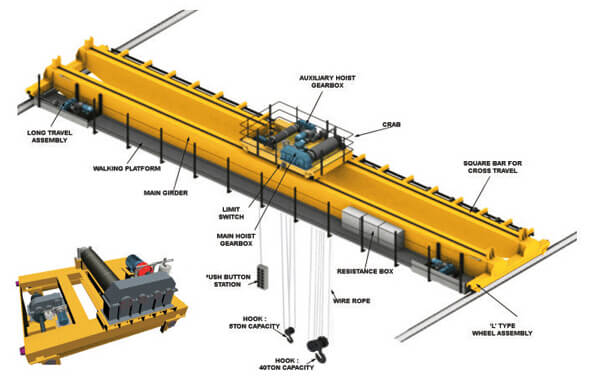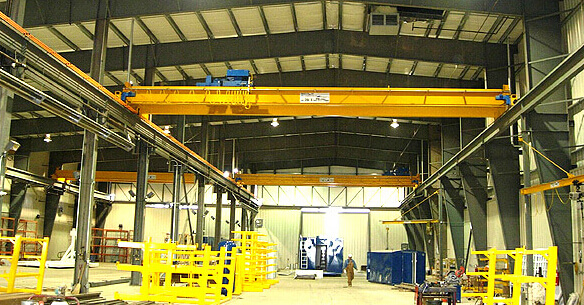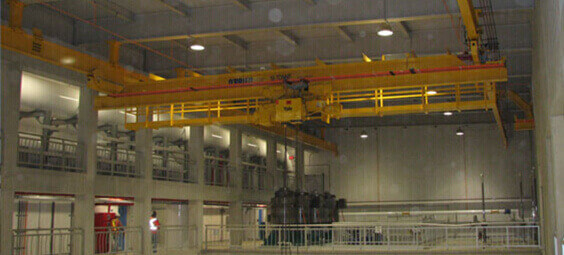Overhead crane overview
An overhead crane machine also known as bridge crane, overhead travelling crane, or industrial crane is a material handling machine which lifts, lowers, and transport a load horizontally. Typically, an overhead crane involves a hook-and-line mechanism that moves along a horizontal beam which moves on a runway beam, the supporting structure.
Overhead canes are heavy duty material handling equipment with high lifting capacities for transporting load. Overhead crane travel is directed by an operator, either manually or with a wired pendant station or wireless controls. Typically, overhead crane is used for the multi-directional movement of materials to help manufacturing, storing, loading or unloading works inside a facility or outside in a yard, or at a railway, or shipping port, and other application environments.
Overhead crane components
Generally, the overhead crane is consisted of three main parts, the crane bridge, the hoist or trolley, and the runway. The crane bridge is the part which traverses across the runway. The hoist or trolley is the lifting mechanism which traverses across the crane bridge and lifts vertically.
The runway is tied to the building structure. Besides, there are other parts are involved, showing in the following diagram for your reference.

Double Girder Overhead Crane componets drawing
Basic crane terminology
Crane capacity: The maximum weight the overhead crane is required to handle.
Crane span: The horizontal distance between the rails of runway on which the crane travels.
Lift or hook height:The distance from the floor to the crane hook, which determines the height of the runway from the floor and is subjected to the clear inside height of the building.
Bridge, trolley and lift speeds: The rate at which the bridge or trolley runs or at which the hoist lifts. Dual speeds are available.
Crane bridge: The main travelling structure of overhead crane which is consisted of two end trucks and one or two bridged girders varying with the type of the crane.
End trucks: The end trucks is located on both sides of the span. The end trucks house the wheels on which the crane runs.
Bridge girder(s):Bridge girder is the principal horizontal beam of the crane bridge which is supported by the end trucks. The bridge girder of the crane is meat to support the trolley.
Trolley hoist: The trolley hoist is consisted of hoist and the trolley frame. According to the lifting requirements, one or more hoist can be installed, which can be supplied on the same trolley or on separate trolleys.
Trolley: The trolley takes the hoist across the bay along bridge girder(s) traversing the span.
Hoist: Hoist is mounted to the trolley and is the main lifting equipment together with the crane hook or other lifting attachment.
Overhead crane configuration
Overhead crane mainly have two configurations: Top running overhead cranes and under running overhead cranes.
Top running overhead cranes
The top running overhead crane or bridge crane refers to the crane which has the bridge travel on the top of rails mounted on a runway beam supported by either the building columns or columns specifically engineered for the crane. The top running overhead crane or bridge crane is the most common crane configuration with the feature that the crane loads are transmitted to the supporting columns or free standing structure and with the advantage of minimum head room and maximum height of lift.

Top running overhead crane
Classification of top running overhead cranes
Top running overhead cranes can be further classified into single girder, double girder, and box girder overhead crane or bridge crane in terms of girder types.
single girder overhead crane or bridge crane is consisted of two end trucks, trolley hoist unit and a single bridge girder, on the bottom flange of which the trolley runs on.
Single girder overhead crane designed for your application can be cost-effective. Single girder overhead crane has lower wheel loads so that it will save on new support structures and it will also allow you to add more lifting capabilities to your runway structure without upgrading.
Double girder overhead crane or bridge crane is consisted of two end trucks, trolley hoist unit and two bridge girders, on the top of which located the rails on which the trolley runs.
Double girder overhead crane provides better hook height for the hoist of the double girder overhead crane is mounted on top of the bridge rather than underneath.
Box girder overhead crane or bridge crane is a crane equipped on a girder formed by multiple walls in the shape of enclosed tube, rather than on an I-beam or H-beam.
Box girder overhead crane is used for heavy duty material handling with the feature of extremely rigidity and durability.
Under running overhead cranes
Under-running or under-hung overhead crane or bridge crane has the end trucks ride on the bottom flange of the runway, which is usually suspended from the roof, with no need of extra floor columns for the support of the runway. The under-running or under-hung overhead crane has the advantage of taking no floor space and saving cost for supporting system. Moreover, an under-running or under-hung overhead crane can be applied to the sloped ceilings or multiple crane systems.

Under running overhead crane
Classification of under-running or under-hang overhead crane
In terms of crane girder, the under-running or under-hang overhead cranes can be grouped into single girder, double girder and box girder overhead cranes.
Single girder under running overhead crane provides you a cost effective material handling solution for it can save new support structure because of its reduced wheel loads, which also makes it possible to add more lifting capabilities without upgradation.
Double girder under running overhead crane is usually used for handling loads over 25 tons, which is usually provided with a complete material handling solution. Double Girder Cranes provides a higher lifting height for the crane hook travels between the beams, comparing with that of the single girder overhead crane.
Overhead crane comparison -top running Vs. under running
To choose the top running or under running overhead crane is mainly determined by two factors:
- Capacity: Even though the under running overhead crane can be up to 25 ton capacity, the practical limit is more like 15 tons.
- Support structure: Under running overhead crane can be suspended directly from the overhead steel for the lighter duty crane. Top running overhead cranes needs a bracket off the building support steel (up to 10 tons capacity) or independent columns for larger capacities.
Top running overhead crane configuration is best used when headroom is an issue. Double girder top running configuration is the most space efficient one. Whereas when the headroom is not an issue a top or under running configuration can be either single girder or double girder.
Overhead crane application
Overhead crane or bridge crane can be applied for material handling in various situations and industries, such as, Automotive, Beverage, Chemicals, Commercial printing, Manufacturing, Newspaper, Paper, Steel and warehousing and distribution, etc.
- Assembly: Overhead cranes are used to move the products through production processes.
- Transportation: Overhead cranes are used to transport the finished products onto open trailers or other vehicles.
- Staging: Holding work-in-process for additional production processes.
- Storage: Overhead crane also can be used to transport heavy item into or out of the storage area.
- Warehousing: Heavy items can be moved with overhead cranes to and from docks.
Overhead cane advantages
Overhead crane are most applied material handling equipment for the following advantages:
- Adaptable: Due to overhead crane cane be operated on any plant floor surface and also because they can be modified to accommodate changing needs, overhead cranes provide high adaptability.
- Customizable: Customized overhead cranes are available. The below hook attachments, riggings, and other special material handling tool to deal with the variety of loads.
- Comfortableness: The design of overhead cranes takes the comfortableness of crane operators into consideration, which would improve the efficiency and safety in the working area.
- Efficiency: Overhead cranes lift loads up and over obstacles with high efficiency without navigating back and forth through aisles.
- Load control: Radio remote control, pendant pushbutton control, and driver’s cabin control are also at your choice for your overhead cranes.
- Lower maintenance costs: Adopting with advanced technologies and offered in a variety of usage of capacity ratings, overhead cranes need less maintenance comparing with other lifting equipment.
- Positioning: The overhead cranes can place the loads to an exact location with high precision.
- Reduce labor cost: A set of single overhead crane can replace many forklifts and cover a large work area.
- Lower damage to loads: With soft start features, wide selection of speed options, and a variety of handling tools or riggings, the loads can be safely handled.
- Safety: Varity of safety measures are installed on overhead cranes to ensure the safety of your lifting equipment, crane operator and loads, etc.
- Higher lifting height: Overhead cranes can provide you a higher lifting height with higher efficiency.
没有评论:
发表评论